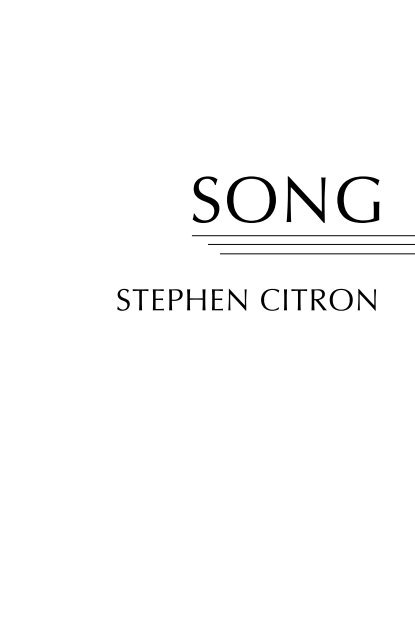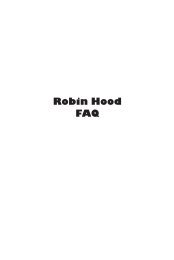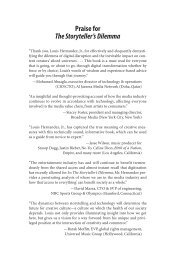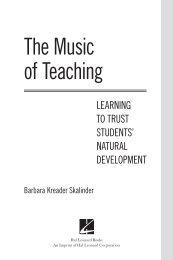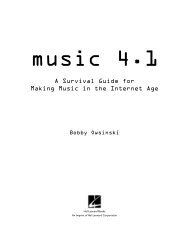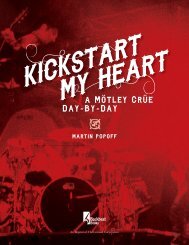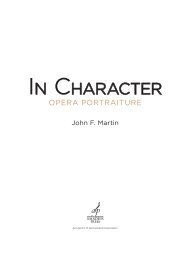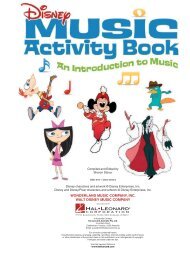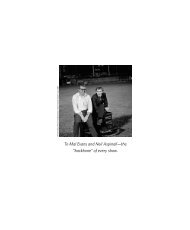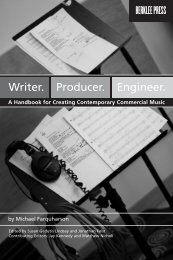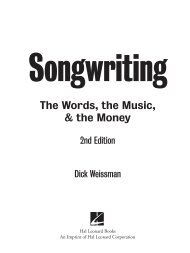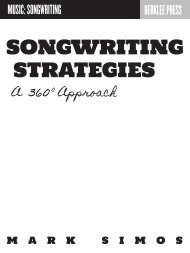Songwriting - A Complete Guide to the Craft Revised and Updated Edition
Create successful ePaper yourself
Turn your PDF publications into a flip-book with our unique Google optimized e-Paper software.
SONG<br />
STEPHEN CITRON
WRITING<br />
A <strong>Complete</strong> <strong>Guide</strong> <strong>to</strong> <strong>the</strong> <strong>Craft</strong><br />
Limelight <strong>Edition</strong>s · New York
Limelight <strong>Edition</strong>s<br />
An Imprint of Hal Leonard Corporation<br />
19 West 21st Street, New York, NY 10010<br />
Copyright © 1985, 2008 by Stephen Citron<br />
All rights reserved. No part of this book may be reproduced in any form, without<br />
written permission, except by a newspaper or magazine reviewer who wishes <strong>to</strong> quote<br />
brief passages in connection with a review.<br />
Second edition published in 2008 by Limelight <strong>Edition</strong>s<br />
First edition published in 1985 by William Morrow<br />
Reprinted in 1990 by Limelight <strong>Edition</strong>s<br />
Printed in <strong>the</strong> United States of America<br />
Book design by Kristina Rol<strong>and</strong>er<br />
Grateful acknowledgment is made for permission <strong>to</strong> quote song lyrics <strong>and</strong> music as<br />
detailed in <strong>the</strong> Permissions section, which begins on page 313.<br />
Library of Congress Cataloging-in-Publication Data is available upon request.<br />
ISBN: 978-0-87910-357-6<br />
www.limelighteditions.com
CONTENTS<br />
PREFACE TO THE NEW EDITION<br />
PREFACE<br />
ACKNOWLEDGMENTS<br />
xiii<br />
xv<br />
xvii<br />
FIRST CONSIDERATIONS 1<br />
Concept 1<br />
Which Comes First, Melody or Lyrics? 3<br />
Collaboration 5<br />
Finding <strong>and</strong> Working with a Collabora<strong>to</strong>r 6<br />
How Much Technical Training Do You Need? 7<br />
Supplies 8<br />
PART I: LYRICS<br />
1 CONSTRUCTION AND FORM 13<br />
How <strong>and</strong> Why We Label Form 14<br />
How <strong>and</strong> Why We Label Rhymes 15<br />
Verses <strong>and</strong> Choruses 16<br />
Folk Songs 22<br />
Spirituals 24<br />
Blues, Classic <strong>and</strong> Pop 26<br />
Operettas 30<br />
1900–1920 34<br />
1920s 37<br />
1930s <strong>and</strong> 1940s 37<br />
Musical Theater Since World War II 42<br />
The Late Forties 42<br />
The Fifties 44<br />
The Sixties 48<br />
The Seventies 49<br />
The Eighties 52<br />
The Nineties 52<br />
The Twenty-first Century 53
vi / CONTENTS<br />
Rock 53<br />
Rock <strong>and</strong> Roll 53<br />
The Beatles <strong>and</strong> <strong>the</strong> Revolution in Form 56<br />
Rock 59<br />
Acid Rock 60<br />
Hard Rock 63<br />
Bubblegum 64<br />
Folk-Rock 65<br />
The Seventies 66<br />
The Eighties 67<br />
Country 68<br />
Your Style 72<br />
2 TYPES OF SONGS 75<br />
Starting with Parodies 75<br />
Things <strong>to</strong> Remember When Writing Parody 76<br />
Writing Lyrics <strong>to</strong> Songs in <strong>the</strong> Public Domain 77<br />
Things <strong>to</strong> Remember When Writing Lyrics <strong>to</strong> Songs in <strong>the</strong> Public Domain 78<br />
Writing a Lyric <strong>to</strong> Already Existing Music 78<br />
Translations 79<br />
S<strong>to</strong>ry Songs 81<br />
Dos <strong>and</strong> Don’ts for S<strong>to</strong>ry Songs 84<br />
Descriptive Songs 84<br />
Situation Songs 88<br />
Some Situations for Song 91<br />
List Songs 91<br />
Tips on <strong>the</strong> List Song 94<br />
Social Message Songs 94<br />
Birthday Songs 95<br />
Foreign or Pseudo-Foreign Songs 96<br />
Patriotic Songs 96<br />
Holiday Songs 97<br />
Gimmick Songs 98<br />
Nonsense Songs 99<br />
Suggestions for Writing Nonsense Songs 100<br />
Punch-Line Songs 100<br />
Inspirational Songs 102<br />
Gospel Songs 102<br />
Love Songs 103<br />
Unsuitable Concepts 105
CONTENTS / vii<br />
3 RHYME 107<br />
What Makes Rhyme? 109<br />
Paper Rhymes 109<br />
Identical Rhymes 109<br />
Regional Rhymes 110<br />
Imperfect <strong>and</strong> False Rhymes 110<br />
One-, Two-, <strong>and</strong> Three-Rhymes 111<br />
Inner Rhymes 113<br />
Non-Rhymed Lyrics 114<br />
Rhyme Schemes 115<br />
Original Rhyme Schemes 117<br />
Words That Will Not Rhyme 119<br />
4 WORD USAGE 123<br />
Simile <strong>and</strong> Metaphor 123<br />
Alliteration 124<br />
Onoma<strong>to</strong>poeia 125<br />
Words That Do Not Sing 125<br />
Connecting <strong>the</strong> Words 126<br />
Inverted Language 127<br />
Filling Out or Telescoping a Lyric 127<br />
Matching Accents <strong>and</strong> Meaning 127<br />
Inappropriate Speech 128<br />
Poets’ H<strong>and</strong>books <strong>and</strong> Rhyming Dictionaries 129<br />
PART II: MUSIC<br />
5 MELODY 133<br />
The Basics of Notating a Melody 133<br />
The Staff 135<br />
Sharps, Flats, <strong>and</strong> Naturals 136<br />
Bar Lines 137<br />
Time Signature 138<br />
Time Values 139<br />
The Major Scale 142<br />
Putting It All Toge<strong>the</strong>r 143<br />
Transposition 145
viii / CONTENTS<br />
Key Signature 146<br />
In Which Key Shall I Write My Song? 147<br />
Accidentals 148<br />
Intervals 149<br />
Motives 155<br />
How <strong>to</strong> Turn <strong>the</strong> Title in<strong>to</strong> a Musical Motive 156<br />
Single-Note Motives 157<br />
Two-Note Motives 158<br />
Three-Note Motives 159<br />
Motives of Four or More Notes 160<br />
Where <strong>to</strong> Take <strong>the</strong> Motive 161<br />
How <strong>to</strong> Freshen a Worn Motive 164<br />
Exp<strong>and</strong>ing <strong>the</strong> Motive in<strong>to</strong> a Phrase 167<br />
Exp<strong>and</strong>ing <strong>the</strong> Phrase in<strong>to</strong> a Period 168<br />
Range 169<br />
Tessitura 170<br />
Melisma 171<br />
Sequence 171<br />
Some Rules for Melody Writing 172<br />
What Your Song Should Include 173<br />
The A 1 173<br />
The A 173<br />
The Bridge or Release 174<br />
The A 3 176<br />
The B <strong>and</strong> C 176<br />
The Coda 176<br />
The Interlude (Trio) 178<br />
The Extension 178<br />
The Verse 179<br />
The Fade 179<br />
6 CHORDS 181<br />
Triads 182<br />
Major Triads 182<br />
Minor Triads 182<br />
Diminished Triads 183<br />
Augmented Triads 183<br />
Triad Abbreviations 184<br />
Scale-Tone Triads 184<br />
The Numerical Relationship 184<br />
Seventh Chords 185
CONTENTS / ix<br />
The Dominant Seventh 186<br />
The Major Seventh 186<br />
The Minor Seventh 186<br />
The Altered Chords 187<br />
The Diminished Seventh 188<br />
Scale-Tone Sevenths in Series 189<br />
Altering Scale-Tone Chords 189<br />
Inversions 190<br />
Added Sixth Chords 190<br />
Ninth Chords 190<br />
Eleventh <strong>and</strong> Thirteenth Chords 191<br />
7 SCALES 193<br />
Major Scale 193<br />
Relative Minor <strong>and</strong> Parallel Minor Scales 194<br />
Harmonic Minor Scale <strong>and</strong> Melodic Minor Scale 195<br />
Scale-Tone Triads in Minor <strong>and</strong> Scale-Tone Sevenths in Minor 196<br />
O<strong>the</strong>r Scales 197<br />
Modal Scales 197<br />
Ethnic Scales 198<br />
Color Scales 199<br />
8 HARMONY 201<br />
Two-Chord Harmony 202<br />
Two-Chord Harmony in Minor 203<br />
Three-Chord Harmony 204<br />
Three-Chord Harmony in Minor 205<br />
Changing Harmony for Intensification 206<br />
Imperfect Cadence 206<br />
II V I 208<br />
I VI II V 210<br />
Commercial Bridge 212<br />
Bridges in <strong>the</strong> Minor 213<br />
Bridges That Modulate <strong>to</strong> Foreign Keys 213<br />
The Circle of Chords 214<br />
Diminished Cliché 217<br />
Old-Fashioned Ending 218<br />
Bass Lines 218<br />
Ascending 219<br />
Ascending Through <strong>the</strong> Augmented 219
x / CONTENTS<br />
Descending 220<br />
Descending in Minor 221<br />
Chord Substitution 221<br />
Intensifying <strong>the</strong> Chords 222<br />
Suspension 222<br />
Anticipation 222<br />
Scale-Tone Substitution 223<br />
Turnarounds 224<br />
Evasion 225<br />
Blues Melody <strong>and</strong> Harmony 226<br />
9 RHYTHM 229<br />
Beat 229<br />
Tempo 230<br />
Meter 230<br />
Rhythm 232<br />
How Rhythm Fills <strong>the</strong> Music 234<br />
Syncopation 235<br />
Rhythms of Popular Music 236<br />
March 236<br />
Fox-trot 237<br />
Modified Fox-trot 237<br />
Shuffle 237<br />
Boogie 238<br />
Ragtime 238<br />
Cakewalk 238<br />
Polka 239<br />
Alley Cat 239<br />
Gavotte 239<br />
Minuet (Menuet) 239<br />
Waltz 240<br />
Bos<strong>to</strong>n Waltz 240<br />
Country Waltz 240<br />
Jazz Waltz 241<br />
Gospel Waltz 241<br />
Charles<strong>to</strong>n 241<br />
Jazz Rhythms 242<br />
Jig (Gigue) 242<br />
9/8 243<br />
12/8 243<br />
Country 243
CONTENTS / xi<br />
Disco 244<br />
Tango (Habanera) 244<br />
Tango (Argentine) 244<br />
Bolero 245<br />
Merengue 245<br />
Cha-Cha 246<br />
Conga 246<br />
Guaracha 246<br />
Rumba 246<br />
Beguine 247<br />
Mambo 247<br />
Samba 248<br />
Bossa Nova 248<br />
Paso Doble 248<br />
Reggae 248<br />
Bo Diddley 249<br />
Punk Rock 249<br />
AFTER THE SONG IS COMPLETED 251<br />
Getting a Song on Paper 251<br />
Lead Sheets 251<br />
When preparing a lead sheet 252<br />
Three-Stave Arrangements 254<br />
Things <strong>to</strong> remember about three-stave arrangements 255<br />
Two-Stave Arrangements 255<br />
Things <strong>to</strong> remember about two-stave arrangements 257<br />
Arrangements for a Group 257<br />
Professional Copies 257<br />
Getting Your Song Recorded 259<br />
Home Demos 259<br />
Studio Recording 259<br />
Copyright 261<br />
How <strong>to</strong> Copyright a Song 262<br />
Instructions for Filling Out Copyright Form PA 263<br />
What You Cannot Copyright 266<br />
How Much Can You Quote? 266<br />
Language of <strong>the</strong> Music Industry 267<br />
Unions, Agencies, <strong>and</strong> Organizations 273<br />
AFTERWORD 277
xii / CONTENTS<br />
APPENDIX 279<br />
Bluegrass 279<br />
Gangsta Rap 280<br />
Heavy Metal 281<br />
Hip-Hop 281<br />
Hip-Hop in <strong>the</strong> Twenty-first Century 282<br />
How <strong>to</strong> Go About Creating a Hip-Hop Song 283<br />
Music-Notation Software 284<br />
Public Domain Songs 285<br />
Punk Rock 285<br />
Rap 286<br />
Reggae 288<br />
Ska 289<br />
GLOSSARY 291<br />
BIBLIOGRAPHY 309<br />
PERMISSIONS 313<br />
INDEX 321
2 TYPES OF SONGS<br />
The first section analyzed form <strong>and</strong> <strong>the</strong> different styles of song lyrics so that<br />
when you wrote something, it would sound professional. This section will be<br />
devoted <strong>to</strong> <strong>the</strong> different types of songs that professional composer-lyricists write.<br />
Sometimes it is an assignment for an industrial show, sometimes a needed flip<br />
side of a record. Occasionally, a performer asks for a piece of special material.<br />
Sometimes a songwriter goes beyond <strong>the</strong> purely creative because of a desire for a<br />
record that will hit <strong>the</strong> charts.<br />
I believe, <strong>and</strong> would suggest, that <strong>the</strong> beginning songwriter should create<br />
several songs in each of <strong>the</strong> following categories. Advanced songwriters may use<br />
this section when <strong>the</strong>y are scrounging around for ideas or looking for a concept.<br />
STARTING WITH PARODIES<br />
I have found in my classes that <strong>the</strong> easiest way <strong>to</strong> approach lyric writing for <strong>the</strong><br />
first time is through writing parodies. Parody is a wonderful exercise for putting<br />
<strong>the</strong> correct number of syllables against a given melody.<br />
So many lyricists are fascinated with word games (after all, <strong>the</strong>y are constantly<br />
fitting syllables in<strong>to</strong> a given number of notes). They fall naturally in<strong>to</strong> parody.<br />
Anyone interested in working in advertising will need <strong>to</strong> be able <strong>to</strong> write parodies,<br />
for many commercials are parodies of songs we know. If you are an amateur<br />
lyricist, parody is useful for organization meetings, goodbye luncheons, <strong>and</strong><br />
o<strong>the</strong>r occasions. Parodies <strong>to</strong> melodies that are in <strong>the</strong> public domain (not under<br />
copyright) can be published but must have <strong>the</strong> approval of <strong>the</strong> original crea<strong>to</strong>r.
76 / LYRICS<br />
Things <strong>to</strong> Remember When Writing Parody<br />
l. The song you parodize must be well known. There is no sense parodizing<br />
an obscure song like “London in July” because <strong>the</strong> listener must be able<br />
<strong>to</strong> imagine <strong>the</strong> original song as <strong>the</strong> parody goes by. “Hello, Dolly” could<br />
become “Goodbye, Ronnie” or “Bonsoir, Fifi,” or “Shalom, Molly.” “New<br />
York, New York” could become “L.A., L.A.” or “Detroit, Detroit.”<br />
2. The accents must match. Nothing is worse than humor h<strong>and</strong>led clumsily.<br />
“Newark, Newark” as a parody for “New York, New York” would make any<br />
listener cringe.<br />
3. The rhymes must come in <strong>the</strong> same places as <strong>the</strong> original. Analyze <strong>the</strong><br />
rhyme scheme of <strong>the</strong> song you are parodizing, <strong>and</strong> be sure your song follows<br />
it (see below).<br />
4. As a general rule, treat your subject with humor or irony. Topical references<br />
make amusing parodies, but of course <strong>the</strong>y don’t have a long life. Nothing<br />
is duller than yesterday’s news.<br />
“New York, New York” (Music by<br />
John K<strong>and</strong>er, Lyric by Fred Ebb)<br />
Start spreadin’ <strong>the</strong> news (1)<br />
I’m leavin’ <strong>to</strong>day (2)<br />
I want <strong>to</strong> be a part of it (3)<br />
New (4) York, New York.<br />
These vagabond shoes (1)<br />
Are longin’ <strong>to</strong> stray (2)<br />
And step around <strong>the</strong> heart of it (3)<br />
New (4) York, New York.<br />
I want <strong>to</strong> wake up in <strong>the</strong> City that<br />
doesn’t sleep (5)<br />
To find I’m king of <strong>the</strong> hill, Top of <strong>the</strong><br />
heap (5)<br />
My little <strong>to</strong>wn blues (1)<br />
Are meltin’ away (2)<br />
I’ll make a br<strong>and</strong> new start of it (3)<br />
In old New (4) York.<br />
If I can make it <strong>the</strong>re (6)<br />
I’d make it anywhere (6)<br />
Come on, come through (4)<br />
New (4) York, New York.<br />
“Attack Iraq” (Lyric by Lizanne Feller)<br />
When critics chimed in (1)<br />
Complained I talk bad (2)<br />
Found me a way <strong>to</strong> make ’em quit (3)<br />
A(4)ttack Iraq.<br />
Convinced ’em I’d win (1)<br />
Outdo dear old dad (2)<br />
While TV spread <strong>the</strong> news of it (3)<br />
A(4)ttack Iraq.<br />
Got re-elected with a m<strong>and</strong>ate for<br />
four more years (5)<br />
By simply wavin’ <strong>the</strong> flag; playin’ on<br />
fears (5)<br />
My schoolboyish grin (1)<br />
Still makes folks feel glad (2)<br />
The press don’t guess <strong>the</strong> ruse of it, (3)<br />
A(4)ttack Iraq.<br />
To get a first-class war (6)<br />
You’ll be remembered for (6)<br />
I tell you, suh, (4)<br />
A(4)ttack Iraq!
TYPES OF SONGS / 77<br />
WRITING LYRICS TO SONGS IN THE PUBLIC DOMAIN<br />
As will be discussed in more detail in <strong>the</strong> section on copyright, every song goes<br />
in<strong>to</strong> public domain (that is when its music or lyrics or both can be used by anyone<br />
without payment of royalty) seventy years after <strong>the</strong> death of its author. If <strong>the</strong> song<br />
is a cooperative effort, it remains under copyright until seventy years after <strong>the</strong><br />
death of <strong>the</strong> last collabora<strong>to</strong>r (see note on public-domain songs in <strong>the</strong> Appendix).<br />
To you, <strong>the</strong> lyricist, this means <strong>the</strong>re are thous<strong>and</strong>s of melodies written by classical<br />
or long-since-deceased composers that are fair game for popular songs.<br />
This idea was born way back in <strong>the</strong> nineteenth century, when French words<br />
were added <strong>to</strong> Chopin’s <strong>the</strong>me for his Etude in E Major (Op. 10, #3), <strong>and</strong><br />
“Tristesse,” as it was called, became a favorite of <strong>the</strong> Parisian salon. Chopin would<br />
have cringed, especially had he realized <strong>the</strong> amount of money being made from<br />
<strong>the</strong> sheet sale of his music, but of course this was a time before copyright laws.<br />
Early in <strong>the</strong> twenties, “I’m Always Chasing Rainbows” was adapted from<br />
Chopin’s Fantasie-Impromptu. Then <strong>the</strong> favorite composer for music stealing<br />
became Tchaikovsky. His “Moon Love” (Fifth Symphony), “Our Love” (Romeo<br />
<strong>and</strong> Juliet Overture), “Tonight We Love” (Piano Concer<strong>to</strong>), “This Is <strong>the</strong> S<strong>to</strong>ry of a<br />
Starry Night” (Sixth Symphony) were all well-known hits of <strong>the</strong> forties <strong>and</strong> fifties.<br />
This Russian composer’s mine of melody was <strong>the</strong> basis of all <strong>the</strong> songs used in Walt<br />
Disney’s full-length animated feature Sleeping Beauty as well. “The Anniversary<br />
Song,” one of <strong>the</strong> big hits of <strong>the</strong> forties, is a Russian waltz by Ivanovici <strong>to</strong> which<br />
words have been appended. Nor were French composers immune. Debussy was<br />
tapped for his “Reverie,” which became “My Reverie.” Ravel’s “Pavane (for a Dead<br />
Princess)” became “The Lamp Is Low.”<br />
When Wright <strong>and</strong> Forrest succeeded with “Song of Norway,” using <strong>the</strong> music<br />
of Edvard Grieg, <strong>the</strong>y were launched in<strong>to</strong> <strong>the</strong> big time. They continued with<br />
Kismet, using Borodin’s music, <strong>and</strong> had a song that hit <strong>the</strong> charts — “Stranger<br />
in Paradise.” They followed this with an adaptation of <strong>the</strong> Anastasia s<strong>to</strong>ry, using<br />
Rachmaninoff’s music, but by this time both <strong>the</strong> vogue <strong>and</strong> <strong>the</strong>ir inspiration had<br />
flown.<br />
Classically trained singers have always enjoyed classical melodies whose range<br />
shows off <strong>the</strong> breadth of <strong>the</strong>ir voices. For Mario Lanza, <strong>the</strong> traditional Neopolitan<br />
folk song “O Sole Mio!” was adapted <strong>to</strong> become “There’s No Tomorrow.”<br />
Simon <strong>and</strong> Garfunkel had one of <strong>the</strong>ir greatest successes with “Scarborough<br />
Fair,” although this was a revival of a medieval melody, <strong>and</strong> not strictly in <strong>the</strong><br />
realm of adaptation. The most successful of all is probably Elvis Presley’s “Love<br />
Me Tender,” which is merely a new lyric for <strong>the</strong> old song “Aura Lee.”<br />
More recent adaptations have included Barry Manilow’s “Could It Be Magic,”<br />
which is based on <strong>the</strong> chords of Chopin’s Prelude in C Minor; Walter Murphy’s<br />
“A Fifth of Beethoven;” <strong>and</strong> Eric Carmen’s adaptation of Rachmaninoff called<br />
“Never Gonna Fall in Love Again.”
78 / LYRICS<br />
Things <strong>to</strong> Remember When Writing Lyrics <strong>to</strong> Songs in<br />
<strong>the</strong> Public Domain<br />
1. Check with <strong>the</strong> Library of Congress in Washing<strong>to</strong>n, D.C., <strong>to</strong> be sure <strong>the</strong><br />
song is in <strong>the</strong> public domain. Very old songs like “Tea for Two,” “Alex<strong>and</strong>er’s<br />
Ragtime B<strong>and</strong>,” <strong>and</strong> “Happy Birthday” are, surprisingly, still under<br />
copyright. Don’t risk a lawsuit.<br />
2. Check for singability. Some songs may be in <strong>the</strong> public domain, but have<br />
<strong>to</strong>o broad a range for successful adaptation (Puccini arias). They may have<br />
<strong>to</strong>o many notes per square inch, which makes <strong>the</strong>m more instrumental than<br />
vocal (Scott Joplin’s “The Entertainer” or “Maple Leaf Rag”).<br />
3. Go back <strong>to</strong> <strong>the</strong> original melody <strong>and</strong> adapt your lyric <strong>to</strong> this, not <strong>to</strong> some<br />
o<strong>the</strong>r lyricist’s or composer’s version, which may be different enough from<br />
<strong>the</strong> original <strong>to</strong> be under copyright. If you follow <strong>the</strong> published version of<br />
“Down in <strong>the</strong> Valley,” which varies slightly from <strong>the</strong> original folk tune, you<br />
would be liable for copyright infringement.<br />
4. Do not use <strong>the</strong> entire melody of a classical piece. Be sure you adapt by<br />
taking out any sections difficult <strong>to</strong> sing. Adapt means simplify.<br />
5. Give credit <strong>to</strong> <strong>the</strong> original composer (under <strong>the</strong> title). Too many songwriters<br />
are shy about mentioning that <strong>the</strong>ir original melody came from ano<strong>the</strong>r<br />
source. I believe it takes a certain sense of originality <strong>and</strong> a great feeling<br />
for what is timely <strong>to</strong> create an adaptation. Most musicians will know <strong>the</strong><br />
origin of <strong>the</strong> melody anyway, so be big about it, <strong>and</strong> approach adaptation<br />
as an art.<br />
WRITING A LYRIC TO ALREADY EXISTING MUSIC<br />
Throughout <strong>the</strong> forties <strong>and</strong> fifties, movie <strong>the</strong>mes were wordless. Every one of<br />
<strong>the</strong> big b<strong>and</strong>s had its own wordless <strong>the</strong>me song. Sometimes <strong>the</strong> public clamored<br />
<strong>to</strong> sing some purely instrumental songs, <strong>and</strong> lyricists were assigned (with varying<br />
degrees of success) <strong>to</strong> versify <strong>the</strong> music. The technique is not easy <strong>to</strong> master, for<br />
instrumental music can often have wide skips that are hard <strong>to</strong> sing, or a bunch of<br />
notes strung <strong>to</strong>ge<strong>the</strong>r that sound marvelous as part of a saxophone riff but make<br />
words impossible <strong>to</strong> underst<strong>and</strong>.<br />
“Laura” (music by David Raksin, lyric by Johnny Mercer) has become a st<strong>and</strong>ard<br />
of <strong>the</strong> jazz reper<strong>to</strong>ire, <strong>and</strong> it started life as a movie <strong>the</strong>me. Johnny Mercer aimed<br />
<strong>to</strong> distill <strong>the</strong> leading character’s fabulous beauty <strong>and</strong> mystery, <strong>and</strong> he succeeded<br />
notably:<br />
Laura, is <strong>the</strong> face in <strong>the</strong> misty night<br />
Footsteps that you hear down <strong>the</strong> hall,<br />
The laugh that floats on a summer night
TYPES OF SONGS / 79<br />
That you can never quite recall.<br />
And you see Laura on a train that is passing by<br />
Those eyes, how familiar <strong>the</strong>y seem<br />
She gave your very first kiss <strong>to</strong> you<br />
That was Laura,<br />
But she’s only a dream!<br />
The <strong>the</strong>me from a successful Bette Davis movie, Now, Voyager, became a song<br />
entitled “Wrong, Could It Be Wrong <strong>to</strong> Love?” <strong>and</strong> <strong>the</strong> expansive <strong>the</strong>me from<br />
Gone with <strong>the</strong> Wind became “My Own True Love.” Of course, <strong>to</strong>day movie songs<br />
come complete with lyrics, but <strong>the</strong>re are still successful instrumentals that need<br />
words.<br />
Johnny Mercer did a masterful job of setting Erroll Garner’s <strong>the</strong>me song “Misty,”<br />
noteworthy in <strong>the</strong> section where Garner’s melody sweeps up <strong>to</strong> a sustained note.<br />
He h<strong>and</strong>les <strong>the</strong>se spots cleverly by using throw-away words on <strong>the</strong> quick notes<br />
leading <strong>to</strong> strong words like clinging, sound, <strong>and</strong> right foot.<br />
In <strong>the</strong> “One-Note Samba,” his task is even more complicated, because he must<br />
get so many notes in<strong>to</strong> <strong>the</strong> rapid tempo. I print <strong>the</strong> bridge opposite.<br />
All <strong>the</strong>se rapid-fire pitches are intelligible because Mercer has chosen short<br />
syllables.<br />
TRANSLATIONS<br />
When a song becomes successful in one country, its record may be released<br />
internationally. Aware that most people want <strong>to</strong> sing it in a language <strong>the</strong>y<br />
underst<strong>and</strong>, <strong>the</strong> publisher <strong>and</strong> <strong>the</strong> recording company will hire a lyricist <strong>to</strong><br />
translate <strong>the</strong> song. (It is rare indeed for a song like “Volare (Nel Blu, Di Pin<strong>to</strong> Di<br />
Blu)” <strong>to</strong> reach <strong>the</strong> <strong>to</strong>p of <strong>the</strong> charts when sung in its original Italian, as was <strong>the</strong><br />
case in 1958.)
80 / LYRICS<br />
The lyricist is provided with a literal translation. If you are ever hired <strong>to</strong><br />
translate a foreign song, I hope you will approach <strong>the</strong> project as most professional<br />
lyricists do. They use <strong>the</strong> original lyric as a point of departure <strong>and</strong> often take off<br />
from <strong>the</strong>re. They get <strong>the</strong>ir ideas from <strong>the</strong> title <strong>and</strong> <strong>the</strong> musical line.<br />
Johnny Mercer turned Jacques Prévert’s rueful poem Les Feuilles Mortes (The<br />
Dead Leaves) in<strong>to</strong> a splendid lyric called “The Autumn Leaves.” He observed all<br />
<strong>the</strong> rules of lyric writing by starting with <strong>the</strong> hook or title <strong>and</strong> closing with it. In<br />
addition, he assembled all <strong>the</strong> images <strong>to</strong> make a chronological climax at <strong>the</strong> peak<br />
of <strong>the</strong> music. He was setting Prévert’s concept, <strong>and</strong> not translating exactly. Most<br />
important, he was being led by <strong>the</strong> balance in <strong>the</strong> music <strong>and</strong> its emotion. Kosma,<br />
<strong>the</strong> composer, had set <strong>the</strong> place where <strong>the</strong> rhymes should come. I quote from <strong>the</strong><br />
beginning <strong>and</strong> end of <strong>the</strong> song.<br />
“Les Feuilles Mortes”<br />
C’est un chanson<br />
Qui nous rassemble,<br />
Toi, tu m’aimais<br />
Et je t’amais<br />
Et la mer efface<br />
Sur le sable<br />
Les pas des amants<br />
Désunis.<br />
“The Dead Leaves”<br />
(literal translation)<br />
This is a song<br />
That resembles us.<br />
You, you loved me<br />
And I loved you<br />
And <strong>the</strong> sea erases<br />
On <strong>the</strong> s<strong>and</strong><br />
The footsteps of <strong>the</strong><br />
Disunited lovers.<br />
“The Autumn Leaves”<br />
The autumn leaves<br />
Drift by my window<br />
The falling leaves<br />
Of red <strong>and</strong> gold<br />
But I miss you<br />
Most of all, my darling,<br />
When autumn leaves<br />
Start <strong>to</strong> fall.<br />
It is rare indeed, <strong>and</strong> usually sounds dreadful, when <strong>the</strong> transla<strong>to</strong>r uses a literal<br />
translation, but it is advisable <strong>to</strong> come close <strong>to</strong> <strong>the</strong> original title, <strong>to</strong> capitalize on<br />
whatever success <strong>the</strong> song may so far have achieved. “Two Loves Have I” is an<br />
exact translation of “J’ai Deux Amours”; “Mon Homme” translates <strong>to</strong> “My Man.”<br />
Conversely, “Duerme?,” which became “Feelings,” <strong>and</strong> “Que Reste-t’il” (literally,<br />
“what remains”), which became “I Wish You Love,” have nothing <strong>to</strong> do with <strong>the</strong>ir<br />
original foreign titles <strong>and</strong> were hits anyway. Perhaps <strong>the</strong>y are <strong>the</strong> exceptions that<br />
prove <strong>the</strong> rule.<br />
Often it is better <strong>to</strong> leave evidence of <strong>the</strong> song’s foreign roots in <strong>the</strong> lyric. Edith<br />
Piaf’s “La Vie en Rose” was retitled “You’re Too Dangerous, Chérie” <strong>and</strong> flopped<br />
miserably, but when <strong>the</strong> intriguing French title was retained <strong>and</strong> a new, more<br />
intimate lyric was written, it became a st<strong>and</strong>ard.<br />
O<strong>the</strong>r well-known translations are “Speak <strong>to</strong> Me of Love”; “Mack <strong>the</strong> Knife”;<br />
“If You Love Me, Really Love Me”; “The Girl from Ipanema”; “Love Is Blue”;<br />
“Pigalle”; “El Rancho Gr<strong>and</strong>e”; “What Now, My Love?”; <strong>and</strong> “Gloria.”
TYPES OF SONGS / 81<br />
STORY SONGS<br />
After parody, where <strong>the</strong> rhythm is laid out for <strong>the</strong> lyricist <strong>and</strong> even <strong>the</strong> subject<br />
<strong>to</strong> be parodized is suggested, <strong>the</strong> next kind of song <strong>to</strong> try is a s<strong>to</strong>ry song. Every<br />
one of us has <strong>the</strong> ability <strong>to</strong> make up some sort of s<strong>to</strong>ry. Sometimes <strong>the</strong> point of<br />
departure can be folklore or fairy tale or even an intriguing article in a newspaper.<br />
Often <strong>the</strong> s<strong>to</strong>ry will need a twist, like <strong>the</strong> “Piña Colada Song” (“Escape”), in<br />
which he doesn’t know that his “lovely lady” likes piña coladas; he advertises for<br />
someone who does, <strong>and</strong> his “lovely lady” answers <strong>the</strong> ad. This switch makes <strong>the</strong><br />
s<strong>to</strong>ry interesting. It also lends itself <strong>to</strong> three choruses. Country songs are frequently<br />
s<strong>to</strong>ry songs. “The Coward of <strong>the</strong> County” is a good example.<br />
An original gem is Cole Porter’s “The Tale of <strong>the</strong> Oyster.”<br />
A 1<br />
THEME<br />
Down by <strong>the</strong> sea lived a lonesome oyster,<br />
Ev’ry day getting sadder <strong>and</strong> moister<br />
He found his home life awf’lly wet<br />
And longed <strong>to</strong> travel with <strong>the</strong> upper set<br />
Poor little oyster!<br />
REPEAT OF<br />
A 1 THEME<br />
A 1 THEME<br />
ALTERED<br />
HARMONICALLY<br />
A 1 THEME<br />
ALTERED<br />
MELODICALLY<br />
BRIDGE<br />
Fate was kind <strong>to</strong> that oyster, we know,<br />
When one day <strong>the</strong> chef from <strong>the</strong> Park Casino<br />
Saw that oyster lying <strong>the</strong>re<br />
And said, “I’ll put you on my bill of fare.”<br />
Lucky little oyster!<br />
See him on his silver platter<br />
Watching <strong>the</strong> queens of fashion chatter,<br />
Hearing <strong>the</strong> wives of millionaires<br />
Discuss <strong>the</strong>ir marriages <strong>and</strong> <strong>the</strong>ir love affairs.<br />
Thrilled little oyster!<br />
See that bivalve social climber<br />
Feeding <strong>the</strong> rich Mrs. Hoggenheimer;<br />
Think of his joy as he gaily glides<br />
Down <strong>to</strong> <strong>the</strong> middle of her gilded insides.<br />
Proud little oyster!<br />
After lunch Mrs. H. complains<br />
And says <strong>to</strong> her hostess, “I’ve got such pains!<br />
I came <strong>to</strong> <strong>to</strong>wn on my yacht <strong>to</strong>day,<br />
But I think I’d better hurry back <strong>to</strong> Oyster Bay.”<br />
Scared little oyster!


